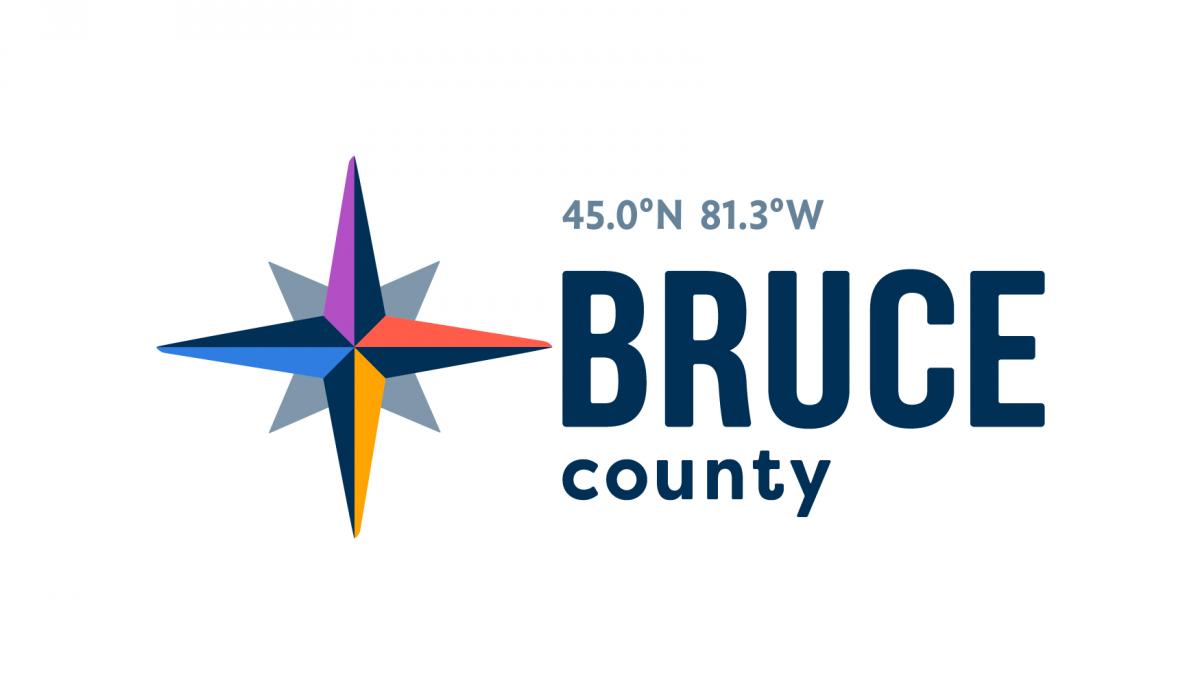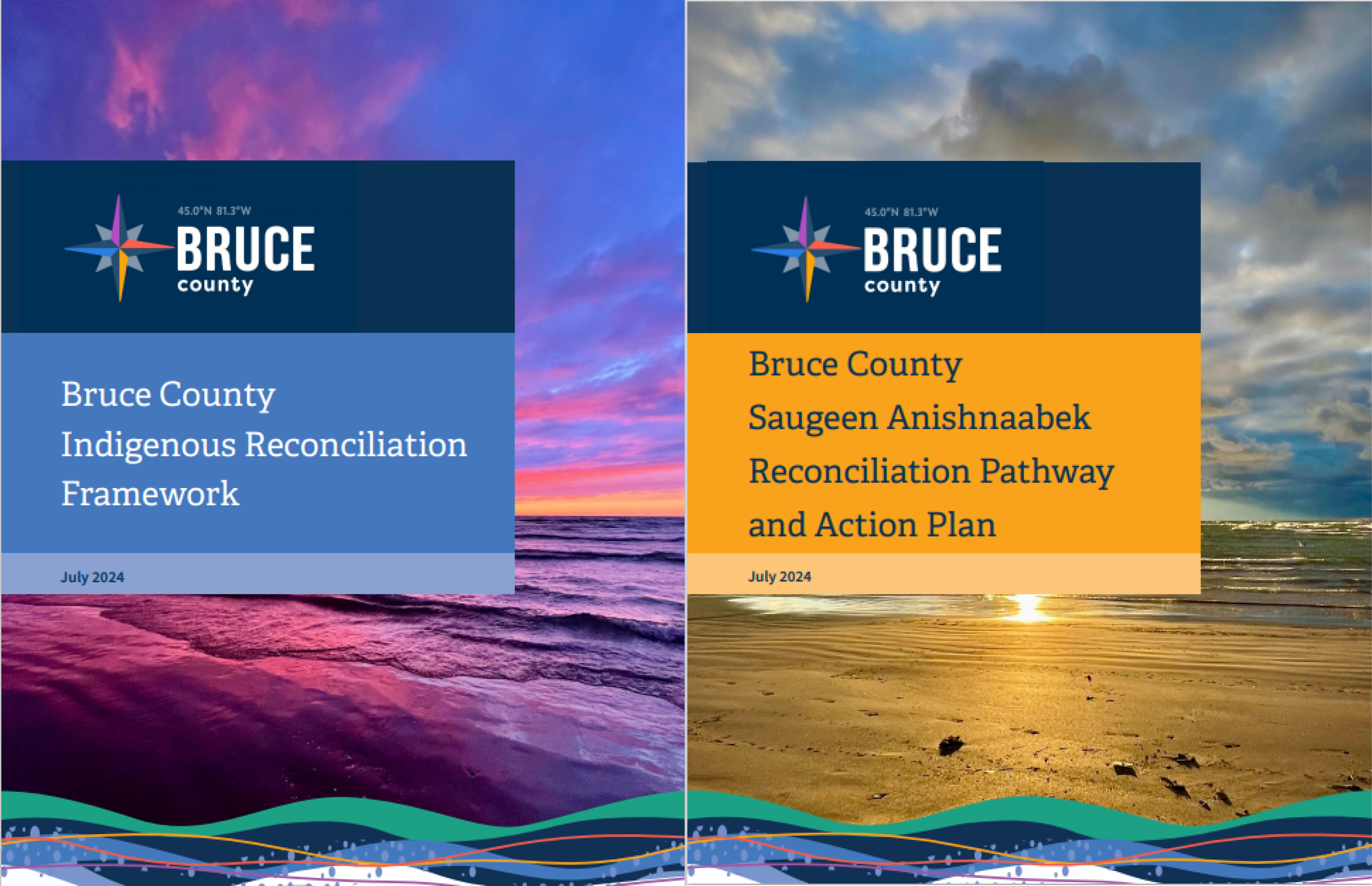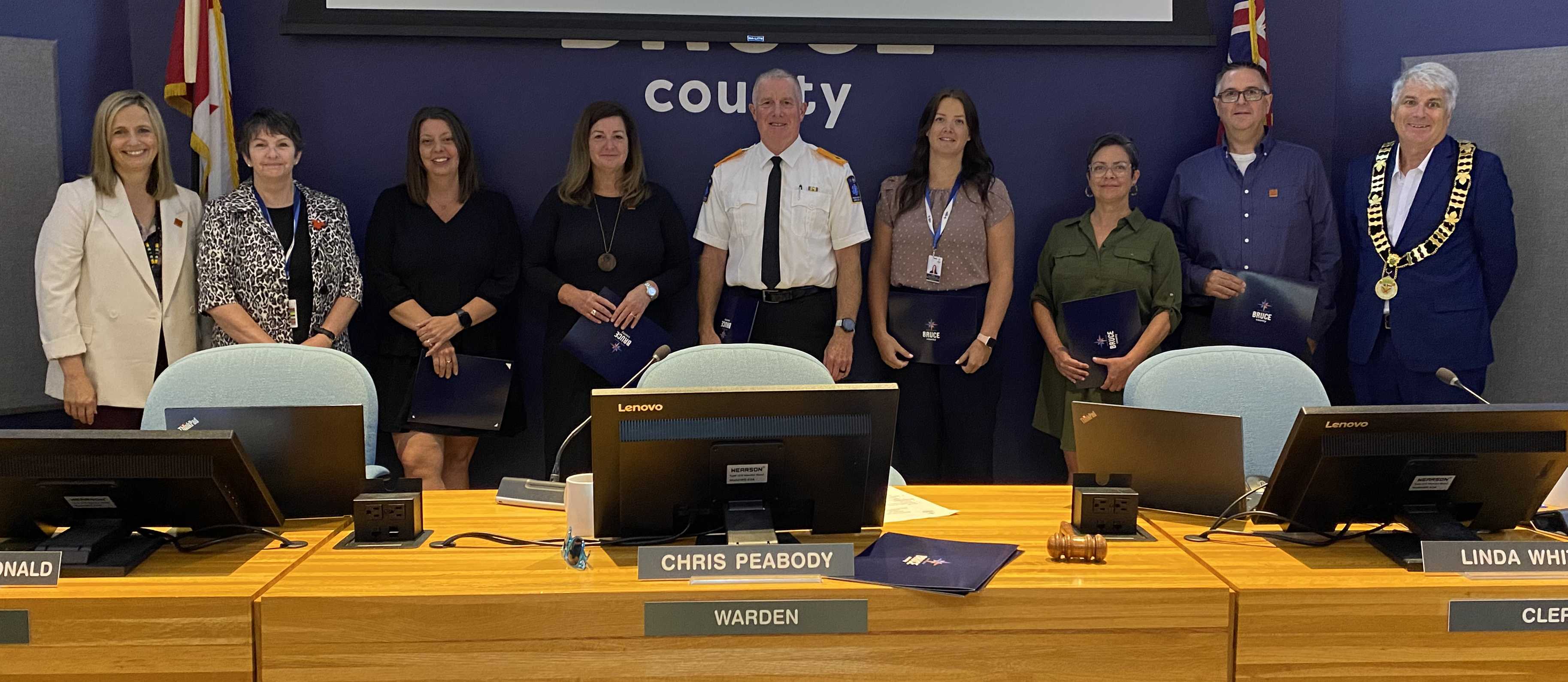Walking Together
Walking Together: Bruce County's Journey Toward Indigenous Reconciliation
By: Matt Meade
October 2024
Introduction - Answering the Call to Reconciliation

While the federal and provincial governments are often seen as the main actors in this space, the TRC emphasized the role of municipalities in fostering Reconciliation, especially since over 85% of Indigenous peoples in Ontario live within municipal boundaries. Local governments are on the frontlines of service delivery and community building, making them essential players in advancing Reconciliation at a grassroots level.
Bruce County, located on the traditional territories of the Chippewas of Nawash Unceded First Nation and Saugeen First Nation, collectively known as the Saugeen Ojibway Nation (SON), took this call to heart. The County’s relationship with these First Nations is amplified by our shared history and geography. Recognizing this, Bruce County embarked on a significant and comprehensive journey toward reconciliation, marked by the development of the Indigenous Reconciliation Planning Initiative and ultimately the Indigenous Reconciliation Framework, and the Saugeen Anishnaabek Reconciliation Pathway and Action Plan.
This blog delves into that journey - its beginnings, milestones, and the steps Bruce County is taking to foster meaningful Reconciliation.
Planting the Seeds of Reconciliation - The Indigenous Reconciliation Planning Initiative
Bruce County’s formal journey towards Reconciliation began in January 2022 with the launch of the Indigenous Reconciliation Planning Initiative. This initiative represented a thoughtful, phased approach designed to build awareness and capacity across the County while laying the groundwork for developing a practical, action-oriented Reconciliation Plan. The process began with the establishment of a Steering Committee, bringing together representatives from several departments across Bruce County.
At its core, the initiative had two primary objectives:
- Education and Training To foster a deeper understanding of Indigenous cultures, histories, and contemporary issues across Bruce County’s organization.
- Reconciliation Action Plan Development To develop a collaborative Reconciliation Action Plan unique to Bruce County, built in partnership with Indigenous peoples. This plan would guide future efforts and set measurable goals toward Reconciliation.
Bruce County understood that reconciliation is not a box to be checked but a continuous process that requires ongoing education, reflection, and dialogue. True Reconciliation is about repairing relationships that have been damaged by centuries of systemic oppression and building new, respectful relationships that are based on trust and mutual understanding.
The County hired NVision Insight Group Inc., a majority Indigenous-owned consulting company, whose expertise in Indigenous cultural awareness training and Reconciliation processes proved invaluable. NVision provided tools and training to guide the County through its Reconciliation journey, ensuring that Bruce County’s efforts were both authentic and effective.
Building Capacity and Awareness - A Key Pillar of Reconciliation
The first objective of the Indigenous Reconciliation Planning Initiative was to increase Indigenous cultural awareness throughout Bruce County. For Reconciliation to be meaningful, staff and leaders needed a shared understanding of the history and experiences of Indigenous peoples. Bruce County recognized that building this foundation of knowledge was essential to ensuring its Reconciliation efforts were genuine and impactful.
Within their educational suite known as "The Path," NVision presents three distinct cultural awareness training programs focused on Truth and Reconciliation, with each successive course building upon the foundations of the preceding. The training was delivered in phases, starting in the spring of 2022. The first course, Your Journey Through Indigenous Canada, offers a comprehensive overview of Indigenous history, culture, and the lasting impacts of colonization. The goal was for all staff, Council members, and Library Board members to complete this course, ensuring a common understanding across our organization. Participants were also invited to participate in post-training "kitchen table" discussions - small, informal sessions that encouraged dialogue, reflections on the material, and provided opportunities to ask questions.
Following the completion of this first course, those staff members and leaders who had more direct engagement with Indigenous people were invited to take the second course, Building Indigenous Intercultural Capacity. This advanced course delved deeper into key concepts like race, culture, unconscious bias, and how to foster intercultural intelligence. For roles requiring direct collaboration with Indigenous peoples, this training was vital to building the necessary skills for respectful and effective engagement.
Bruce County is committed to training new hires in perpetuity, with a regular cohort-based training schedule that will continue to build cultural awareness throughout the organization. Additionally, recognizing the importance of localized learning experiences, the County continues to explore and pursue local learning opportunities to deepen our understanding within our organization - acknowledging that this work must be sustained over time.
Laying the Groundwork for the Reconciliation Action Plan
The second objective of the Indigenous Reconciliation Planning Initiative - the Reconciliation Action Plan Development - was a complex, multi-phase process designed to ensure that Bruce County’s approach to Reconciliation was both thoughtful and responsive to the needs of Indigenous peoples. This action plan ultimately became two guiding documents:
- Indigenous Reconciliation Framework, and;
- The Saugeen Anishnaabek Reconciliation Pathway and Action Plan.
 |
The creation of these documents unfolded in three critical phases:
Phase 1: Landscape for Reconciliation in Bruce County
The first phase of the Reconciliation Action Plan Development laid the groundwork for future efforts by assessing the current state of relationships and understanding of local Indigenous peoples and organizations.
Key actions in this phase included:
Historical Research A comprehensive review of Bruce County’s past interactions with Indigenous peoples and organizations was conducted. This research explored the history of treaties, land use agreements, and the broader context of colonization in the region. Understanding the historical foundations of the County’s relationships with Indigenous peoples was critical to informing future actions.
Stakeholder Mapping In parallel with the historical research, Bruce County mapped key stakeholders involved in the Reconciliation process. This included Indigenous leaders, staff, organizations, and other relevant partners. This mapping exercise helped identify who needed to be engaged for meaningful dialogue and collaboration going forward.
Relationship Assessment Bruce County also conducted an internal assessment of its existing relationships with Indigenous peoples and organizations. This assessment revealed that while there were several informal staff-to-staff connections, there was a need for more formalized structures and commitments. The County recognized the importance of developing stronger, long-term relationships that were built on mutual respect and shared goals.
This foundational work culminated in the "Landscape for Reconciliation in Bruce County Report," which set the stage for the County’s next steps. It provided a clear picture of the gaps that needed addressing and the opportunities for building stronger, more formalized relationships with Indigenous partners. The outcome of Phase 1 was a clear picture of where the County stood in terms of its relationships with Indigenous people and organizations, and where gaps existed that needed to be addressed.
Phase 2: Engagement and Relationship Building
With a strong foundation established, the second phase of the Reconciliation Action Plan Development focused on engaging Indigenous people and organizations and strengthening relationships. This phase was critical for ensuring that the plan was built in true collaboration with Indigenous partners, and it was carried out in two stages:
Internal Engagement The first stage of engagement involved consultations within Bruce County itself. County staff and Council members participated in engagement sessions, surveys, and interviews to share their thoughts on Reconciliation and what actions should be taken to advance it. The internal engagement process helped identify areas where further education was needed and underscored the importance of building stronger, more formalized relationships with Indigenous people and organizations.
External Engagement The second stage focused on external consultations with the communities of Saugeen Ojibway Nation including the Councils of Saugeen First Nation, Chippewas of Nawash Unceded First Nation. Additionally, external consultations occurred with the Métis Nation of Ontario, as well as other Indigenous-serving organizations such as M’Wikwedong Indigenous Friendship Centre. These consultations provided invaluable insights into the priorities and needs of Indigenous people and organizations and helped shape the structure and content of the Indigenous Reconciliation Framework and The Saugeen Anishnaabek Reconciliation Pathway and Action Plan.
The external engagement efforts ensured that Indigenous leaders and community members were central to creating the action plan, allowing the County to deepen its understanding of the issues facing Indigenous peoples and identify actionable steps toward Reconciliation. Insights from both internal and external engagements were consolidated into the comprehensive Engagement Report: What We Heard, which served as the foundation for the Indigenous Reconciliation Framework and the Saugeen Anishnaabek Reconciliation Pathway and Action Plan.
Through our ongoing Indigenous Reconciliation journey, which includes continued education and learning, Bruce County will strive to promote deeper understanding of the distinct rights, cultures, histories, ways of knowing, and priorities of Indigenous peoples and organizations. Informed by consultations, we are adopting a distinctions-based approach, developing, and defining unique Reconciliation pathways and actions with Indigenous peoples in Bruce County through collaboration and partnership.
Phase 3: Drafting, Finalizing, and Delivering
The third and final phase of the Reconciliation Action Plan Development focused on translating the insights from the engagement process into a formal, actionable plan. This phase culminated in the drafting, revision, and eventual implementation of the two guiding documents with anticipation and opportunity for additional Reconciliation Pathway and Action Plans.
Drafting the Indigenous Reconciliation Framework and Saugeen Anishnaabek Reconciliation Pathway and Action Plan
In this phase, Bruce County developed draft versions of two key documents that will guide its Reconciliation efforts:
- The Indigenous Reconciliation Framework This document sets out the County’s overarching long-term vision for Reconciliation, providing guiding principles that shape future actions and decisions.
- The Saugeen Anishnaabek Reconciliation Pathway and Action Plan This plan offers a structured and strategic approach to advance Reconciliation with the Saugeen Anishnaabek, focusing on building and maintaining mutually respectful, government-to-government relationships. It outlines what Bruce County can and will do to address the past and foster positive relationships for the future.
The plan is structured as follows:
- 4 Strategic Goals Long-term goals and desired outcomes, outlining the purpose behind taking action – the why.
- 18 Commitments Specific objectives that Bruce County will accomplish to meet its strategic goals, representing the actions being taken – the what.
- 41 Pathways Specific actions that outline how Bruce County will fulfill its commitments and achieve its strategic goals. These pathways provide clear direction and detail the steps being taken – the how.
Presentation and Feedback from First Nation Band Councils The draft plans were then presented to the councils of Saugeen First Nation and Chippewas of Nawash Unceded First Nation for review and feedback. These presentations allowed for open dialogue and the opportunity for Indigenous leaders to suggest revisions or improvements to the plan. Based on their input, the documents were revised to better reflect Indigenous priorities and align with their visions for Reconciliation.
Endorsement and Finalization After receiving final feedback and making necessary revisions, the two documents were endorsed at the July 4th, special meeting of Bruce County Council.
The Saugeen Anishnaabek Reconciliation Pathway and Action Plan complements the Indigenous Reconciliation Framework by translating its overarching vision and principles into concrete, actionable steps specifically tailored to the needs and aspirations of the Saugeen Anishnaabek (i.e., Chippewas of Nawash Unceded First Nation and Saugeen First Nation, collectively known as the Saugeen Ojibway Nation).
From Vision to Action: Implementing the Indigenous Reconciliation Framework and Saugeen Anishnaabek Reconciliation Pathway and Action Plan
As we begin implementing the Indigenous Reconciliation Framework and Saugeen Anishnaabek Reconciliation Pathway and Action Plan we recognize that these are not static documents. Together, they represent Bruce County’s long-term commitment to Reconciliation, and their implementation will involve clear, measurable actions that will be continuously monitored and updated.
Building and Strengthening Relationships
At the heart of Bruce County’s Reconciliation efforts is the commitment to build and strengthen relationships with Indigenous peoples, beginning with Saugeen Anishnaabek. These relationships are built on trust, respect, and mutual understanding, and they will be fostered through ongoing dialogue and collaboration.
As part of the implementation of the Saugeen Anishnaabek Reconciliation Pathway and Action Plan, Bruce County has committed to holding regular meetings with Indigenous leadership to ensure open lines of communication. These meetings will serve as a platform for discussing progress, addressing challenges, and identifying new opportunities for collaboration. Bruce County recognizes that Reconciliation is not a one-time event but a process that requires ongoing engagement and partnership.
Accountability and Reporting: Ensuring Transparency and Progress
To ensure that Bruce County’s Reconciliation efforts remain transparent and accountable, the County will implement a comprehensive monitoring and reporting system. This system will include the following tools and mechanisms:
- Strategic Plan Implementation Dashboard A public-facing dashboard will be created to track real-time progress on the County’s Reconciliation goals. This dashboard will provide updates on completed actions, upcoming milestones, and overall progress toward the County’s long-term goals.
- Annual Reconciliation Reports Each year, Bruce County will release an Annual Reconciliation Report, highlighting the progress made in implementing the Saugeen Anishnaabek Reconciliation Pathway and Action Plan. This report will celebrate achievements, provide updates on ongoing initiatives, and outline next steps. The annual report will also be aligned with Bruce County’s overall Strategic Plan, ensuring that Reconciliation remains a central focus.
- Annual Leadership Meetings To ensure continued engagement with Indigenous peoples, Bruce County will hold annual joint leadership meetings with the Chippewas of Nawash Unceded First Nation and Saugeen First Nation. These meetings will provide an opportunity for feedback, reflection, and discussion on the progress of the Reconciliation efforts.
By committing to regular reviews, transparent reporting, and continued dialogue with Indigenous leaders, Bruce County ensures that its Reconciliation efforts will remain dynamic, adaptable, and accountable.
Conclusion: Walking the Path of Reconciliation
Through the phased development of the Indigenous Reconciliation Framework and the Saugeen Anishnaabek Reconciliation Pathway and Action Plan, Bruce County has taken meaningful steps toward fostering Reconciliation and building stronger relationships the Chippewas of Nawash Unceded First Nation and Saugeen First Nation. These documents are not the end of the journey but the beginning of a long-term commitment to work collaboratively with Indigenous partners to address the past and create a more inclusive, respectful future.
By engaging in cultural awareness training, consulting with Indigenous peoples, and implementing a clear action plan, Bruce County has laid the foundation for meaningful change. The County remains committed to walking the path of Reconciliation alongside its Indigenous neighbours, ensuring that its actions reflect a deep respect for Indigenous histories, cultures, and contributions.
Photo: Bruce County’s Indigenous Reconciliation Steering Committee received special recognition on September 5, 2024, for their pivotal role in advancing Indigenous Reconciliation. Their leadership and dedication were instrumental in achieving significant milestones, including the approval of the Indigenous Reconciliation Framework and the Saugeen Anishnaabek Reconciliation Pathway and Action Plan on July 4, 2024. Pictured Left to Right: Christine MacDonald, CAO; Cathy McGirr, Director, Museum & Cultural Services; Megan Garland, Director, Long Term Care & Senior Services; Tina Metcalfe, Director, Human Services; Steve Schaus, Director/Chief, Paramedic Services; Jolisa Hamilton, Talent Acquisition & Employee Relations Manager, Human Resources; Jenelle Bannon, Business Development Coordinator, Community Development Office; Matt Meade, Manager, Government Relations; and Bruce County Warden, Chris Peabody.
About the Author

Matt Meade is a key member of the Government Relations team at Bruce County, bringing over eight years of experience in advancing the County’s strategic initiatives. With a focus on fostering community partnerships, Matt has been involved in developing key plans and policies, including those supporting Indigenous Reconciliation, cultural heritage preservation, archeological management and strategic planning. He contributes to Bruce County’s efforts to strengthen relationships with diverse stakeholders and promote inclusive, community-focused initiatives. Matt lives in Port Elgin, Ontario, with his wife and two sons.
For inquiries, Matt can be reached at:
Office: 519-881-1291
Email: MMeade@brucecounty.on.ca
Blog categories: Indigenous, Reconciliation, Community, Planning, Bruce County
